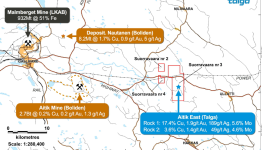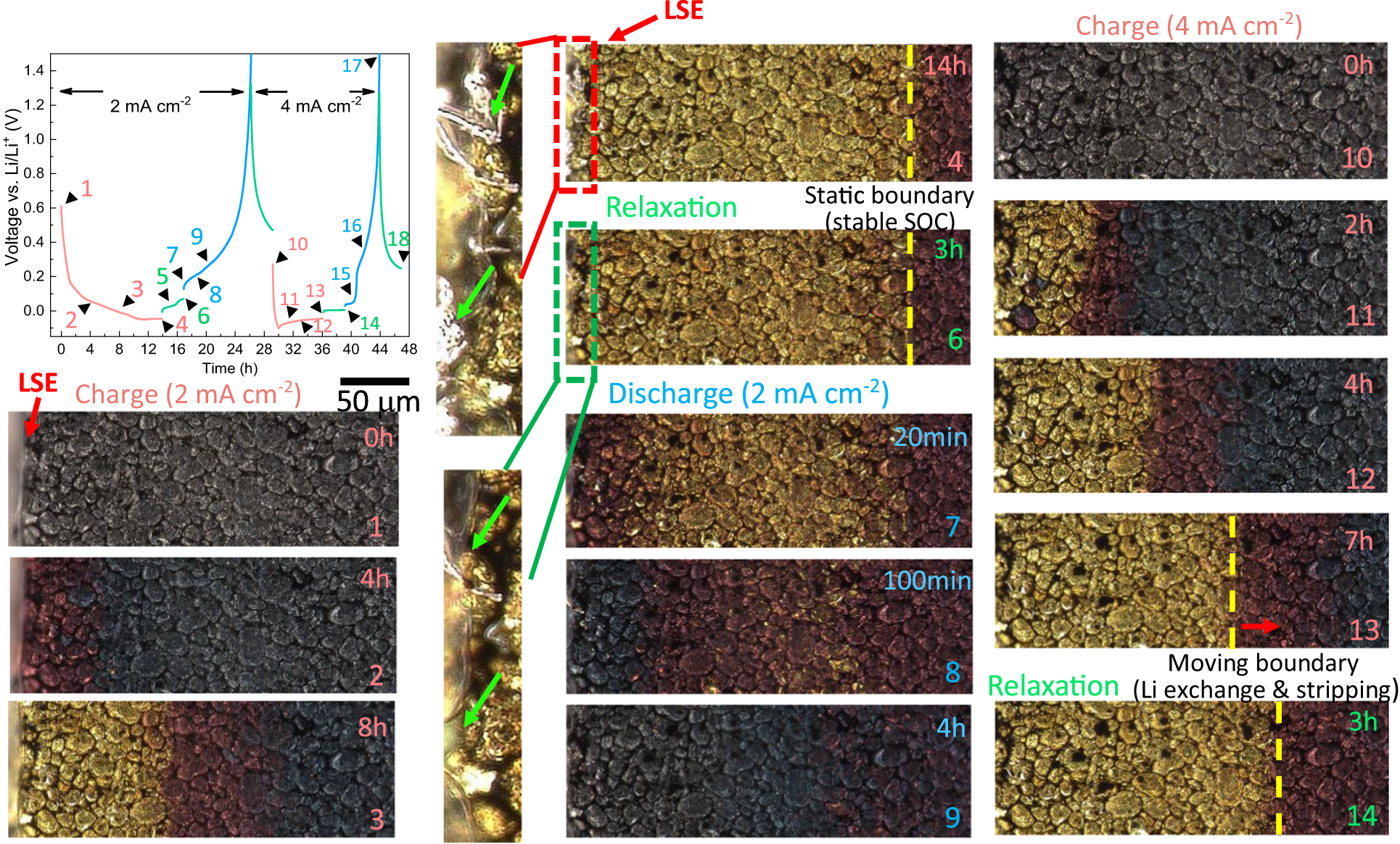But I suspect this only describes the external certification process and not the internal one for producers, so we could deduce from this where we currently are in this process.
We've had this discussion before about who has to fulfil or have the certificates. I am of the opinion that it is the battery producer and not Talga as the supplier of a module, the anode.
"Understanding the Certification Process for Lithium-Ion Batteries
26 Jan 2024
Main topics:
- Demystifying the Certification Process: What You Need to Know about Lithium-Ion Batteries
- Behind the Scenes Exploring the Certification Process for Lithium-Ion Batteries
- Cracking the Code: Deciphering the Certification Process for Lithium-Ion Batteries
- The Ins and Outs of Certifying Lithium-Ion Batteries: Unraveling the Complex Process
- Navigating the Depths: A Comprehensive Guide to Certifying Lithium-Ion Batteries
As technology advances rapidly, we find ourselves in a world that is highly dependent on batteries. From smartphones to electric vehicles, the demand for efficient and long-lasting power sources has increased exponentially. Among various battery options available, lithium-ion batteries have emerged as the go-to choice for many industries due to their exceptional energy density and rechargeable characteristics.
Demystifying the Certification Process: What You Need to Know about Lithium-Ion Batteries
However, the certification process for lithium-ion batteries can be complex and confusing. In this article, we will demystify the certification process, guiding you through what you need to know about lithium-ion batteries.
The Importance of Certification
Before diving into the certification process, it is crucial to understand why certification matters. Certification ensures that the lithium-ion batteries meet specific safety standards, preventing potential hazards such as overheating, explosions, and leakage. In addition to safety, certification also validates the performance and reliability of the batteries.
Relevance bullet points:
- Certification guarantees safety standards are met
- Certification validates battery performance and reliability
- Prevents potential hazards like overheating and explosions
Certification Process Overview
The certification process for lithium-ion batteries consists of several steps that manufacturers follow to ensure regulatory compliance and quality control. Although the process may vary slightly depending on the region and application, the core steps generally remain the same:
- Testing: Extensive testing is conducted to evaluate battery performance, safety, and reliability in various conditions and scenarios.
- Standard Compliance: Manufacturers ensure that their batteries comply with industry standards and regulations such as UL 1642, IEC 62133, and UN 3
- Documentation: Detailed documentation is prepared, including test reports, safety data sheets, and product specifications, to demonstrate compliance with regulatory requirements.
- Third-Party Verification: Some certifications require involvement from third-party testing laboratories or certification bodies to validate the results and ensure impartial assessment.
- Certification Application: Manufacturers submit their documentation and test reports to the relevant certification body, along with the required fees.
- Factory Inspection: In certain cases, the certification body may inspect the manufacturing facility to verify conformity and quality control processes.
- Issuance of Certificate: Once all requirements are met, the certification body issues a certificate indicating compliance with the standards and regulations.
Relevance bullet points:
- Testing is a crucial step in evaluating battery performance and safety
- Compliance with industry standards and regulations is essential
- Documentation plays a vital role in demonstrating compliance
- Third-party verification ensures impartial assessment
- Manufacturers need to submit the documentation to the certification body
- Factory inspection may be conducted for conformity verification
- The issuance of a certificate indicates compliance
Key Considerations for Certification
When venturing into the certification process for lithium-ion batteries, there are some key considerations to keep in mind:
Understand the Application
It is vital to determine the application for which the battery will be used. Different industries and applications may have specific certification requirements. For example, batteries used in medical devices may need to comply with FDA regulations, while electric vehicles must meet automotive industry standards.
Choose the Right Testing Laboratory
Selecting a reputable and accredited testing laboratory is crucial for obtaining reliable and recognized certifications. Look for laboratories that have experience in battery testing and are certified by internationally recognized bodies like ISO 1702
Stay Informed About Regulations
Regulations and standards for lithium-ion batteries are continually evolving. It is crucial to stay updated with the latest requirements to ensure compliance and avoid unnecessary delays or potential issues in the certification process.
Consider Pre-Compliance Testing
Pre-compliance testing can help identify potential issues early on and rectify them before the final certification process. It saves time and resources while ensuring a smoother certification process.
Relevance bullet points:
- Understand specific certification requirements based on the application
- Select reputable and accredited testing laboratories
- Stay updated with evolving regulations and standards
- Consider pre-compliance testing to address potential issues early on
The Benefits of Certified Lithium-Ion Batteries
Certified lithium-ion batteries offer numerous benefits for both consumers and manufacturers. Some key advantages include:
- Enhanced Safety: Certified batteries undergo rigorous testing, ensuring they meet the highest safety standards, minimizing the risk of accidents.
- Quality Assurance: Certification ensures that the battery's performance and specifications are as claimed by the manufacturer, providing peace of mind to both consumers and manufacturers.
- Marketability: Certified lithium-ion batteries gain a competitive edge, as they are perceived as reliable and compliant with industry standards.
- Legal Compliance: Certification is often a requirement to meet legal obligations and gain access to specific markets.
- Longevity: Certified batteries are built to last, offering longer lifespan and improved efficiency, thereby reducing the frequency of replacements.
Key takeaways:
- Certified lithium-ion batteries offer enhanced safety and quality assurance
- They have a competitive edge in the market
- Certification ensures legal compliance and market access
- Longer lifespan and improved efficiency result in fewer replacements
In Conclusion
Understanding the certification process for lithium-ion batteries is crucial for manufacturers and consumers alike. Certification guarantees safety, performance, and reliability while ensuring regulatory compliance. By considering the key factors, choosing the right testing laboratory, and staying informed about regulations, the certification process can be streamlined. The benefits of certified lithium-ion batteries, including enhanced safety, quality assurance, and marketability, make them a preferred choice across various industries. So, whether you're using lithium-ion batteries in electronic devices or electric vehicles, obtaining proper certification is essential for a successful and sustainable battery-powered future.
Behind the Scenes Exploring the Certification Process for Lithium-Ion Batteries
In this article, we dive into the intriguing certification process behind lithium-ion batteries, shedding light on the various stages and standards involved.
The Importance of Certification
Certification plays a vital role in assuring the safety, performance, and reliability of lithium-ion batteries. As these batteries contain potentially hazardous materials and are susceptible to thermal runaway events, it is crucial to adhere to rigorous standards to mitigate any risks associated with their usage.
- Ensuring Safety: The primary objective of certification is to ensure that lithium-ion batteries meet strict safety requirements, minimizing the risk of fires, explosions, and other hazardous incidents.
- Reliability and Performance: Certification also guarantees that the batteries meet performance standards and deliver the promised capacity, energy density, and cycle life.
- Consumer Confidence: By undergoing a thorough certification process, manufacturers help build trust among consumers, assuring them that the batteries they are using meet high safety and performance standards.
The Certification Process
The certification process for lithium-ion batteries is a multifaceted and comprehensive procedure involving several stages. Although the specific process may vary based on the certifying body and the intended application of the batteries, the general framework remains consistent. Let's explore the key stages:
Application Submission
The first step in obtaining certification is to apply to the relevant certifying body. This application typically includes comprehensive information about the battery, its design, specifications, and intended use.
Testing and Evaluation
Once the application is accepted, the batteries undergo rigorous testing and evaluation by accredited laboratories. These tests assess various parameters such as energy density, cycle life, thermal stability, and the ability to withstand abuse conditions.
- Capacity Testing: Determines the battery's actual capacity in comparison to the declared capacity.
- Performance Evaluation: Assesses the battery's performance under normal operating conditions.
- Environmental Testing: Evaluate the battery's behavior in extreme temperatures, humidity, and other challenging environmental conditions.
Compliance with Standards
During the testing phase, the batteries must meet specific standards, such as those set by regulatory bodies like the Underwriters Laboratories (UL) or the International Electrotechnical Commission (IEC). Compliance with these standards ensures uniformity in quality and safety across the industry.
Documentation Review
After the successful completion of the testing phase, the certifying body reviews all the documentation, including test reports, manufacturing processes, and quality control measures. This review ensures that all requirements have been met and that the battery's design and manufacturing processes are consistent with industry best practices.
Certification and Marking
If the batteries successfully pass all the stages, they receive the official certification from the certifying body. Along with the certification, the batteries are marked with the appropriate markings indicating compliance and authenticity.
The Benefits of Certified Lithium-Ion Batteries
Using certified lithium-ion batteries is advantageous for both consumers and manufacturers. Let's take a look at the key benefits:
- Enhanced Safety: Certified batteries offer increased safety measures, reducing the risk of accidents and ensuring the overall well-being of users.
- Improved Reliability and Performance: Certified batteries undergo rigorous testing, guaranteeing their reliability and consistent performance.
- Prolonged Battery Life: With proper manufacturing practices and adherence to standards, certified batteries tend to have longer lifespans, maximizing their usability.
- Compliance with Regulations: Certified batteries comply with stringent regulatory and industry standards, ensuring their legality and acceptability in the market.
- Warranty and Liability: Certified batteries often come with warranty coverage, providing the manufacturer's assurance regarding the product's durability and performance.
In Conclusion
Obtaining certification for lithium-ion batteries is an arduous process that ensures these powerful energy storage devices meet stringent safety and performance standards. Through a comprehensive evaluation and testing process, certified batteries provide enhanced safety, reliability, and performance. By choosing certified batteries, consumers can make informed decisions while manufacturers can strengthen their market position and build trust among their clientele.
Cracking the Code: Deciphering the Certification Process for Lithium-Ion Batteries
The Significance of Lithium-Ion Battery Certifications
Lithium-ion batteries present a myriad of advantages such as high energy density, long cycle life, and quick charging capabilities. However, these advantages come with potential risks. Factors like overheating, short-circuiting, or manufacturing defects can lead to thermal runaway or even explosions.
To mitigate these risks and ensure consumer safety, various organizations and regulatory bodies have established certification standards specifically tailored for lithium-ion batteries. These certifications aim to verify compliance with safety, performance, and environmental requirements.
Let's take a closer look at some of the key certifications in the industry:
UL 1642: The Golden Standard
- Developed by Underwriters Laboratories, UL 1642 is one of the most recognized certifications for lithium-ion batteries worldwide.
- This certification evaluates the safety of lithium-ion cells, ensuring they meet specified requirements for voltage, temperature, and electrical and mechanical abuse.
- UL 1642 assesses both the cells and their component materials, providing crucial guidelines to manufacturers and consumers alike.
IEC 62133: International Compliance
- The International Electrotechnical Commission (IEC) defines the IEC 62133 standard for the safety of secondary lithium cells and batteries.
- This certification is widely accepted globally, emphasizing test criteria for various scenarios like electrical, thermal, and mechanical abuse.
- IEC 62133 also evaluates battery performance under normal and abnormal conditions, verifying their compliance with international safety requirements.
UN33: Safe Transportation
- When it comes to lithium-ion battery transportation, compliance with the UN33 certification is essential.
- UN33 focuses on the safe transportation of lithium-ion batteries and cells by air, land, and sea.
- This certification ensures batteries are tested for safety, including thermal, mechanical, and electrical aspects, to minimize the risks associated with transportation.
The Benefits of Certified Lithium-Ion Batteries
Choosing certified lithium-ion batteries brings several advantages for both manufacturers and consumers:
Enhanced Safety
- Certified batteries undergo rigorous testing to assess safety under various conditions, reducing the risk of accidents or malfunctions.
- Manufacturing defects, improper usage, or environmental factors can compromise battery safety.
- Choosing certified batteries mitigates these risks, providing peace of mind for consumers and minimizing liability for manufacturers.
Quality Assurance
- Lithium-ion battery certifications not only address safety but also ensure reliable performance.
- Certified batteries are tested for their performance capabilities, including capacity, efficiency, and cycle life.
- Manufacturers benefit from a clear set of industry standards, allowing them to benchmark battery performance and enhance overall product quality.
Regulatory Compliance
- Obtaining certifications prove compliance with safety, manufacturing, and environmental regulations set by various governing bodies.
- Compliance enhances brand reputation and facilitates market entry, especially in industries where adhering to specific standards is crucial.
- Additionally, certifications are often prerequisites for partnerships or collaborations with established organizations, enabling manufacturers to expand their market reach.
Key Takeaways: Unveiling the Mysteries of Battery Certifications
Lithium-ion battery certifications serve as fundamental pillars in ensuring safety, quality, and compliance. Here are the key takeaways:
- UL 1642, IEC 62133, and UN33 are among the most important certifications for lithium-ion batteries.
- These certifications evaluate the safety, performance, and transportation aspects of lithium-ion batteries.
- Certified batteries offer enhanced safety, reliable performance, and regulatory compliance.
As the demand for lithium-ion batteries continues to soar, understanding the certification process becomes increasingly vital. Manufacturers must prioritize certifications to deliver safe and dependable battery solutions, while consumers can make informed decisions by choosing certified batteries. By cracking the code of battery certifications, we fortify the foundation of a more sustainable and secure energy future.
The Ins and Outs of Certifying Lithium-Ion Batteries: Unraveling the Complex Process
Certification Standards and Regulations
When it comes to certifying lithium-ion batteries, multiple standards and regulations come into play. These certifications offer a comprehensive framework to evaluate the safety, performance, and reliability of these energy storage systems. Here are some of the notable standards:
- UN/DOT 33: This test, required for shipping lithium-ion batteries, ensures their compliance with safety regulations for air, ground, and sea transportation.
- IEC 62133: This international safety standard defines requirements and tests for the safe operation and handling of lithium-ion batteries used in portable devices.
- UL 1642: This Underwriters Laboratories standard evaluates lithium batteries' safety, including electrical, mechanical, environmental, and thermal aspects.
Complying with these standards showcases a commitment to producing high-quality, safe batteries, and establishing trust among manufacturers, consumers, and regulatory bodies.
The Certification Process
The certification process for lithium-ion batteries can be intricate and time-consuming. Manufacturers must follow a series of steps to ensure their products meet the required standards. Here is a breakdown of the typical process:
- Application: Manufacturers submit their battery design, specifications, and relevant documentation to a certified testing laboratory.
- Testing: The testing laboratory conducts a battery evaluation, including electrical, thermal, and environmental tests, as per the required standards.
- Report Generation: Based on the test results, the laboratory generates a detailed report highlighting the battery's performance and compliance with the specific standards.
- Certification Decision: The certification body reviews the report and, if the battery meets all the requirements, issues the certification.
It's important to note that certification is not a one-time process; manufacturers must regularly renew their certifications to ensure ongoing compliance.
Benefits of Certification
Obtaining certification for lithium-ion batteries offers a multitude of advantages for manufacturers and consumers alike:
- Enhanced Safety: Certification helps identify potential safety hazards and ensures batteries comply with rigorous safety standards, reducing the risk of accidents and malfunctions.
- Quality Assurance: Certification provides a stamp of quality, assuring consumers that the product has undergone comprehensive testing and meets industry standards.
- Market Access: Many countries and regulatory bodies require certified batteries to meet safety and performance criteria before entering their markets, enabling manufacturers to expand their reach and enter new markets seamlessly.
- Competitive Edge: Having certified batteries gives manufacturers a competitive advantage by differentiating their products as safe, reliable, and trustworthy in the market, enhancing brand reputation.
The Future of Battery Certifications
With the rapid advancements in battery technology, the certification process continues to evolve. New standards and regulations are being developed to address emerging challenges and ensure the safety and performance of next-generation lithium-ion batteries.
As electric vehicles gain popularity, certifications such as the ISO 26262 for functional safety in automotive systems are becoming more critical. Additionally, certifications for recycling and environmental sustainability, such as UL 1974 and ISO 14001, are gaining significance in the battery industry.
Key Takeaways
- Lithium-ion battery certification ensures safety, performance, and reliability.
- Standards like UN/DOT 33, IEC 62133, and UL 1642 play a crucial role in the certification process.
- The certification process involves application, testing, report generation, and a certification decision.
- Certification benefits include enhanced safety, quality assurance, market access, and a competitive edge.
- The future of battery certifications includes emerging standards for automotive safety and environmental sustainability.
By obtaining certifications and meeting evolving industry standards, manufacturers can demonstrate their commitment to producing safe and reliable lithium-ion batteries, ultimately promoting consumer trust and fostering the growth of this dynamic industry.
Navigating the Depths: A Comprehensive Guide to Certifying Lithium-Ion Batteries
This comprehensive guide will take you through the process of certifying lithium-ion batteries, providing you with valuable insights and key takeaways.
The Importance of Certifying Lithium-Ion Batteries
Before delving into the certification process, it's crucial to understand why certifying lithium-ion batteries is essential. Here are a few key reasons:
- Safety: Lithium-ion batteries have the potential to cause safety hazards due to their chemical composition. Certification helps identify potential risks and ensures that safety standards are met.
- Reliability: Certifying batteries ensure their performance and reliability, giving consumers confidence in the products they purchase.
- Compliance: Certification is often a requirement to comply with industry regulations and standards.
The Certification Process
Certification of lithium-ion batteries involves multiple stages and assessments. Let's explore the key steps involved:
Design and Manufacturing Evaluation
The first step in the certification process is evaluating the battery's design and manufacturing. This includes assessing factors such as:
- Battery chemistry
- Cell design
- Assembly techniques
- Quality control processes
This evaluation determines if the battery meets the requirements for safety and performance.
Performance Testing
In this stage, the battery undergoes various performance tests to assess its capabilities and adherence to standards. These tests may include:
- Capacity and energy measurements
- Charge and discharge efficiency
- Temperature cycling
- Overcharge and over-discharge protection
Performance testing ensures that the battery operates safely and reliably under different conditions.
Safety Testing
The safety of lithium-ion batteries is of utmost importance as they have the potential to overheat or catch fire. Safety testing involves:
- Thermal stability testing
- Short circuit and overcharge protection
- Crush and nail penetration tests
- Abuse testing
By subjecting batteries to extreme conditions, safety testing ensures they can withstand unexpected events without causing harm.
Environmental Testing
Batteries should be able to endure various environmental conditions. Environmental testing includes:
- Temperature and humidity tests
- Vibration and shock tests
- Salt spray and water immersion tests
By undergoing these tests, batteries can prove their resilience and longevity in real-world situations.
Compliance Assessment
Once the battery completes all tests, a compliance assessment is conducted. This involves comparing the battery's performance and safety with relevant industry standards.
If the battery meets all the required standards and regulations, it can be certified.
Benefits of Certifying Lithium-Ion Batteries
There are several advantages to certifying lithium-ion batteries, including:
- Enhanced safety and reduced risk of accidents
- Improved consumer confidence in the product
- Compliance with industry regulations and standards
- Increased marketability and competitive edge
- Long-term cost savings due to enhanced reliability
In Conclusion
Certifying lithium-ion batteries is a crucial process that ensures safety, reliability, and compliance with industry standards. By undergoing rigorous testing and evaluation, these batteries provide peace of mind to consumers and manufacturers alike. Remember to follow the certification process for your lithium-ion batteries to guarantee their quality and performance.
So, whether you are an electronics manufacturer or an individual looking to purchase a lithium-ion battery-powered device, understanding the certification process is essential.
Ensure your batteries are certified for a safe and reliable experience!"
https://energy5.com/understanding-the-certification-process-for-lithium-ion-batteries






